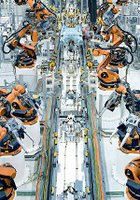Bending the Third Rail
Because We Should, We Can, We Do
Cost of the War in Iraq
(JavaScript Error)
Saturday, January 28, 2006
JIT
 Lancet has a very interesting article (free registration required) about some innovations that are being tried in the Health Care industry. When I first saw the articles subject I was not impressed, thinking that "production line health care" doesn't sound very attractive.
Lancet has a very interesting article (free registration required) about some innovations that are being tried in the Health Care industry. When I first saw the articles subject I was not impressed, thinking that "production line health care" doesn't sound very attractive.I'm not a doctor. But I was the administrator of a non-profit counseling clinic and I can tell you that the vast majority of medical care facilities are very poorly managed. I also worked for years in manufacturing, learning "just in time" production methods and statistical quality control. These production innovations, pioneered originally by the Japanese, have brought about tremendous improvements in U.S. manufacturing efficiency (those that are left that is). It appears that medicine might benefit from these production methods:
The Toyota Production System was developed by the company's founder Sakichi Toyoda, his son Kiichiro Toyoda, but primarily by Taiichi Ohno, a company engineer. The goal of the approach is to refine production so that work flows smoothly from one step to the next with no wasted time, effort, or resources. The essential elements of each step are identified. Any step that does not add value to the product is considered waste or “muda”. The process is then reorganised to eliminate any muda. The new process is then standardised, mistake-proofed, and implemented [by the workers themselves, not some suit]. Then the analysis is done again, and again, and again, a process of continual, incremental improvement called “kaizen” in Japanese.That's a brief history of what JIT (just in time) manufacturing is. Sounds pretty dry, right?
“Every value stream we've ever mapped—and we've mapped all our major processes—in every process there's been over 50% non-value-added time”, Kaplan says.
Using Toyota techniques, Park Nicollet cut patient waiting times to the point that the centre's new ambulatory clinic has no waiting rooms. This is possible because the clinic adopted the “one-piece flow” production system used by Toyota. Before, patients were processed in batches. If there were five examination rooms, for example, patients were scheduled in batches of five. The nurses and doctors would then hustle from room to room hoping to clear the rooms for the next scheduled batch checked in. Delays inevitably occurred, and patients backed up in the waiting rooms.Sounds good to me. I've never found doctors to be particularly social anyway and I usually have found myself spending a lot of time cooling my heels. If done well, this is a real win-win. Consumers get health care delivered in a timely and efficient manner, medical facilities maximize the use of their resources and cut costs.
Now, the patients are “feathered in”, Kaupa says. The first patient of the day is signed in at 0800 h and immediately sent to the exam room, the next patient comes in at 0810, the next at 0820, and so on in 10-minute intervals. The nurse, followed by the doctor, and then perhaps by the lab technician, sees each patient in order so that the services they provide come to the patient in a steady, even “flow”. At the end of the day, no additional patients are signed in after 1600 h, so the clinic gradually empties room by room until it's empty. At closing time the rooms are empty.
0 Comments:
About Me
- Name: Greyhair
- Location: Wine Country, California
I'm a very lucky person with every allergy known to man but still happy to be enjoying a wonderful life living in the best place in the world!
Blogroll
The Big PictureBillmon
Blah3.com
Born at the Crest of Empire
Eric Alterman
Eschaton
FireDogLake
Feingold's Blog
Dan Froomkin
The Huffington Post
Hullabaloo
The Illustrated Daily Scribble
Jesus General
Juan Cole
Matilda's Advice and Rants
Mia Culpa
MsJan Quilts
Needlenose
The Oil Drum
Political Animal
Political Wire
Spooks of the Ozarks
Talk About Corruption
TalkLeft
Think Progress
War and Peace
The Washington Note